Berry
Bite-sized window manager written in C. It is controlled via a command-line client, allowing users to control windows via a hotkey daemon such as sxhkd or expand functionality via shell scripts. It provides extensible theming options with double borders, title bars, and window text. Berry places new windows in unoccupied spaces and supports virtual desktops.

Installation
Once you finish installing Archcraft, Berry can be installed on the top of it. It's pre-configured and ready to go. Open a terminal and run the following command to install Berry :
$ sudo pacman -Sy archcraft-berry
Configuration
Berry is pre-configured in Archcraft. In this section, We'll see how the Berry window manager is configured, what tools and utilities are used to make it look and work like a complete desktop environment.
Config Structure
The configuration structure of Berry in Archcraft looks something like this:
~/.config
└── berry : berry config directory
├── alacritty : terminal config
├── scripts : scripts used for berry
├── theme : desktop theme (polybar, rofi configs)
├── autostart : main berry config file
├── dunstrc : dunst config for notifications
├── picom.conf : compositor config
├── sxhkdrc : keybindings config
└── xsettingsd : gtk themes, icons and fonts config file
Terminal
Alacritty is the default terminal. In the Berry window manager, alacritty is launched with an alternative config file. If you need to change anything, make sure you modify the config files in ~/.config/berry/alacritty directory. These are the following config files you can modify to change the behaviour of your terminal:
~/.config/berry/alacritty/alacritty.toml : Main configuration file
~/.config/berry/alacritty/colors.toml : Colors configurations
~/.config/berry/alacritty/fonts.toml : Fonts configurations
If you need any help with alacritty config, run :
man 5 alacrittyin terminal.
Notification
Dunst is used as a notification daemon for notifications in Berry. In the Berry window manager, dunst is launched with an alternative config file, which is ~/.config/berry/dunstrc. So, If you need to modify anything, make sure you edit this file.
If you need any help with dunst config, run :
man 5 dunstin terminal.
Wallpaper
hsetroot sets the wallpaper in the Berry. If you want to change the wallpaper, Edit ~/.config/berry/scripts/berry_autostart script and add the path to your wallpaper :
# Restore wallpaper
hsetroot -cover '/path/to/your/wallpaper'
Statusbar
Polybar is used as the statusbar in Archcraft's Berry window manager.
The configurations for polybar can be found inside the theme directory directory of Berry ~/.config/berry/theme
If you want to modify the polybar settings, or perhaps want to add/remove modules, then you need to edit the following files :
~/.config/berry/theme/polybar/config.ini : Main config file
~/.config/berry/theme/polybar/colors.ini : Colors config file
~/.config/berry/theme/polybar/modules.ini : Modules config file
If you need any help with polybar config, visit : polybar wiki
Launchers and Applets
Rofi is used for application launchers, command runner and various applets. To modify the rofi config, edit ~/.config/rofi/config.rasi file.
If you need any help with rofi config, run :
man rofiin terminal.
The scripts for rofi that are used in Berry can be found it ~/.config/berry/scripts directory. These are the following scripts that uses rofi to provide the launchers and applets in Berry :
rofi_askpass : rofi based sudo frontend to get root password
rofi_asroot : applet to open apps as root
rofi_bluetooth : bluetooth applet to quickly connect to BT devices
rofi_launcher : an application launcher, cmd runner, file manager and task manager
rofi_music : music applet, that controls MPD with mpc
rofi_powermenu : power menu, with confirmation dialog
rofi_runner : quickly lets you run a command
rofi_screenshot : screenshot applet that works with maim
rofi_windows : applet to manage opened windows
If you want to modify any applet or perhaps want to extend the functionality of the applet, just edit these scripts above.
The configuration of each script can be found inside the theme directory of Berry ~/.config/berry/theme
Let's say you want to modify the looks of launcher, then you need to edit the ~/.config/berry/theme/rofi/launcher.rasi file. Same goes for every other applet, Edit the respective file in the same directory.
If you need any help with rofi theming, run :
man rofi-themein terminal.
To change the colors and fonts of the launchers and applets, Edit the ~/.config/berry/theme/rofi/shared/colors.rasi and ~/.config/berry/theme/rofi/shared/fonts.rasi files.
Compositor
Picom is used for compositing. It's a lightweight compositor with shadowing, advanced blurring and fading. In Berry, picom is launched with an alternative config file, which is ~/.config/berry/picom.conf.
If you need to change anything related to picom, Edit this picom config file.
If you need any help with picom config, check the picom's default config file in
/etc/xdg/picom.conf
If you're having screen-tearing issues, using glx backend can solve this issue.
If you're facing lagging, hangs and freezes, try switching between xrender and glx backend.
Window Manager
The configuration of Berry is available in ~/.config/berry. To configure Berry window manager, these are the files that are used :
autostart : main configuration file responsible for determining the behaviour and settings of the overall session. Edit this file to configure Berry's appearance.
sxhkdrc : Berry does not handle any keyboard input and instead provides the berryc program as its interface. So, For keyboard shortcuts, a hotkey daemon sxhkd is used. Edit this file to add/remove keybindings.
If you need any help with berry configuration, visit : berrywm.org
If you need any help with sxhkd configuration, run :man sxhkdin terminal.
Keybindings
Here's a list of some important keybinds you need to know for operating Berry easily. If you want to view, modify or add new keybinds, Edit ~/.config/berry/sxhkdrc file.
Applications
| Keys | Action |
|---|---|
| super + Return | Open terminal (alacritty) |
| super + shift + Return | Open fullscreen terminal |
| super + F | Open file manager (thunar) |
| super + E | Open text editor (geany) |
| super + W | Open web browser (firefox) |
Menu and Applets
| Keys | Action |
|---|---|
| super | Open application launcher |
| alt + F1 | Open application launcher |
| alt + F2 | Open command runner |
| super + N | Open network manager applet |
| super + B | Open bluetooth applet |
| super + M | Open music applet |
| super + X | Open powermenu applet |
| super + S | Open screenshots applet |
| super + R | Open apps as root applet |
Hardware Keys
| Keys | Action |
|---|---|
| Take screenshot | |
| alt + Print | Take screenshot in 5 seconds delay |
| shift + Print | Take screenshot in 10 seconds delay |
| ctrl + Print | Take screenshot of currently focused window |
| super + Print | Take screenshot of selected area |
| XF86AudioRaiseVolume | Increase volume |
| XF86AudioLowerVolume | Decrease volume |
| XF86AudioMute | Toggle mute speakers |
| XF86AudioMicMute | Toggle mute microphone |
| XF86Audio + Next/Prev/Play/Stop | Media controls (MPD) |
| XF86MonBrightnessUp | Increase display brightness |
| XF86MonBrightnessDown | Decrease display brightness |
Workspaces
| Keys | Action |
|---|---|
| super + 1..9 | Switch to respective workspace |
| super + shift + 1..9 | Send focused window to respective workspace |
Window Management
| Keys | Action |
|---|---|
| super + shift + Left/Down/Up/Right | Resize window |
| super + ctrl + Left/Down/Up/Right | Move window |
| super + Left | Snap left |
| super + Right | Snap right |
| super + Up | Maximize window |
| super + Down | Resize and center window with fixed geometry |
| super + Space | Toggle fullscreen |
| super + T | Toggle decorations |
| super + Tab | Cycle focused windows |
| alt + Tab | Cycle focused windows |
| super + C | Center window |
| super + Q | Close focused window |
| super + shift + C | Close focused window |
Window Manager
| Keys | Action |
|---|---|
| super + shift + Q | Quit berry |
| super + Escape | Reload sxhkd configuration file |
Misc Keys
| Keys | Action |
|---|---|
| ctrl + alt + M | Open ncmpcpp with album art in terminal |
| ctrl + alt + L | Trigger lockscreen |
| super + P | Run colorpicker |
Screenshots
Here's few screenshots of Berry desktop. These'll give you an idea of the experience of Berry in Archcraft.
| Desktop 1 | Desktop 2 | Desktop 3 | Desktop 4 |
|---|---|---|---|
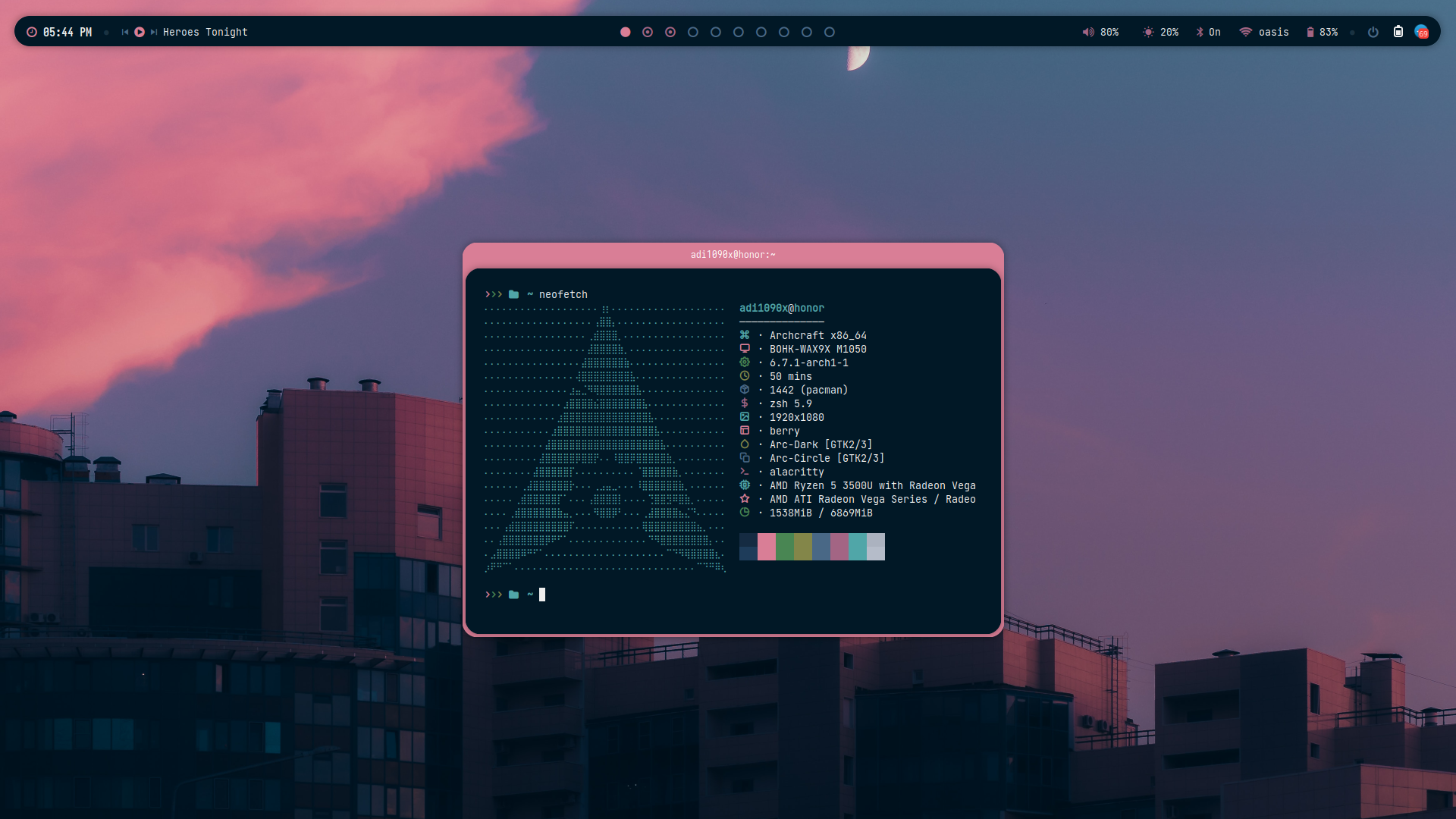 | 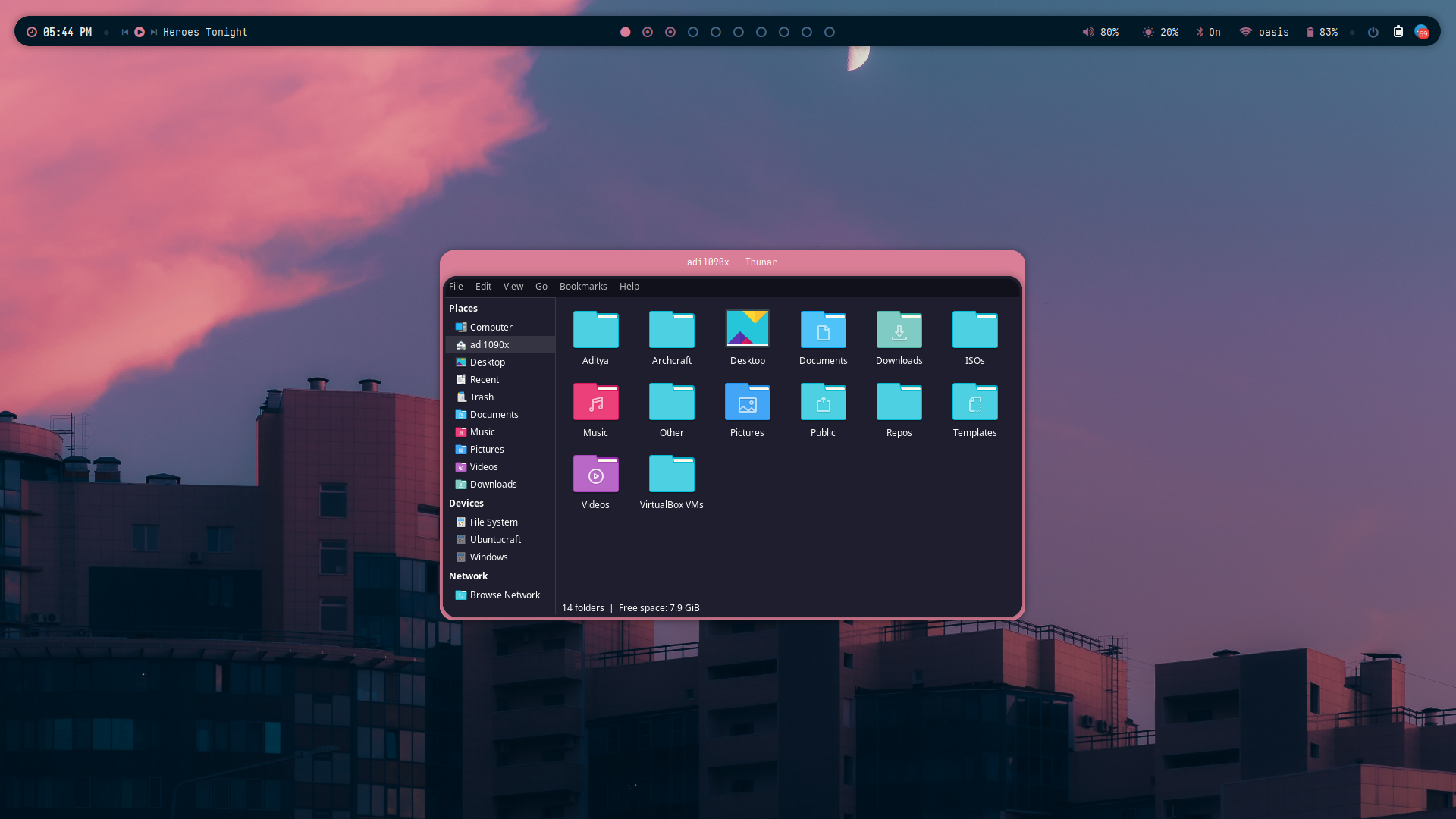 | 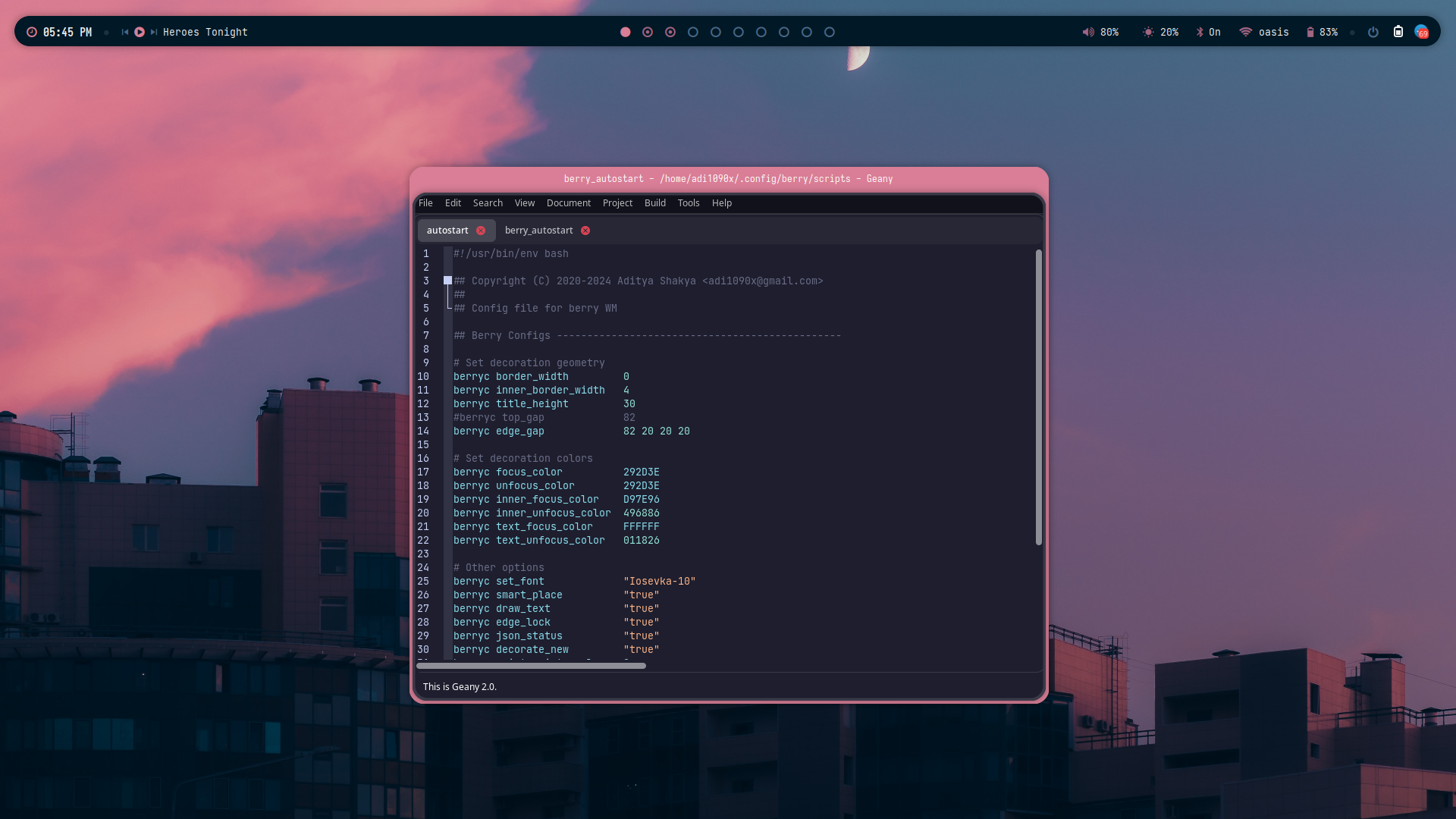 | 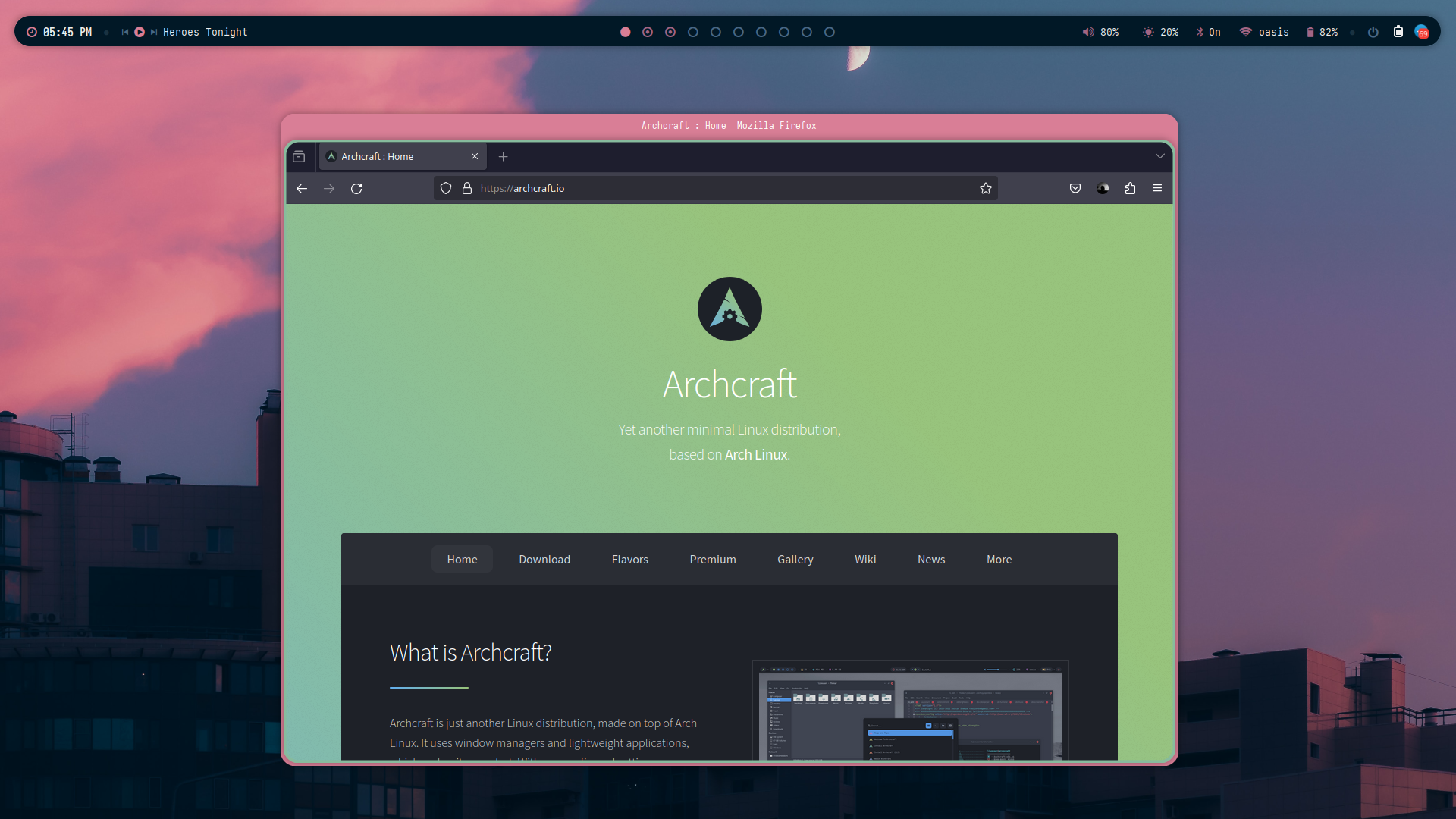 |
| Desktop 5 | Desktop 6 | Desktop 7 | Desktop 8 |
|---|---|---|---|
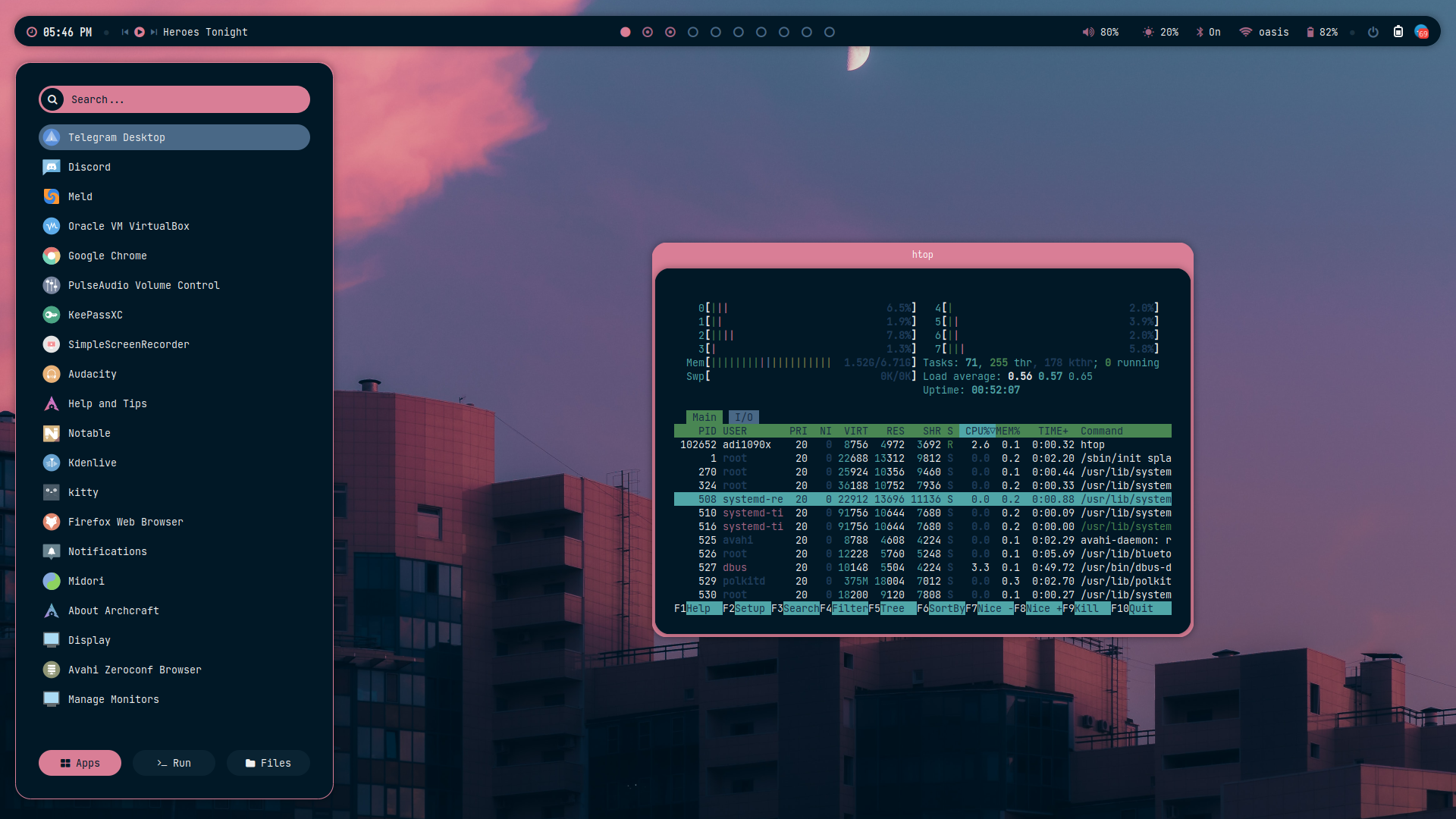 | 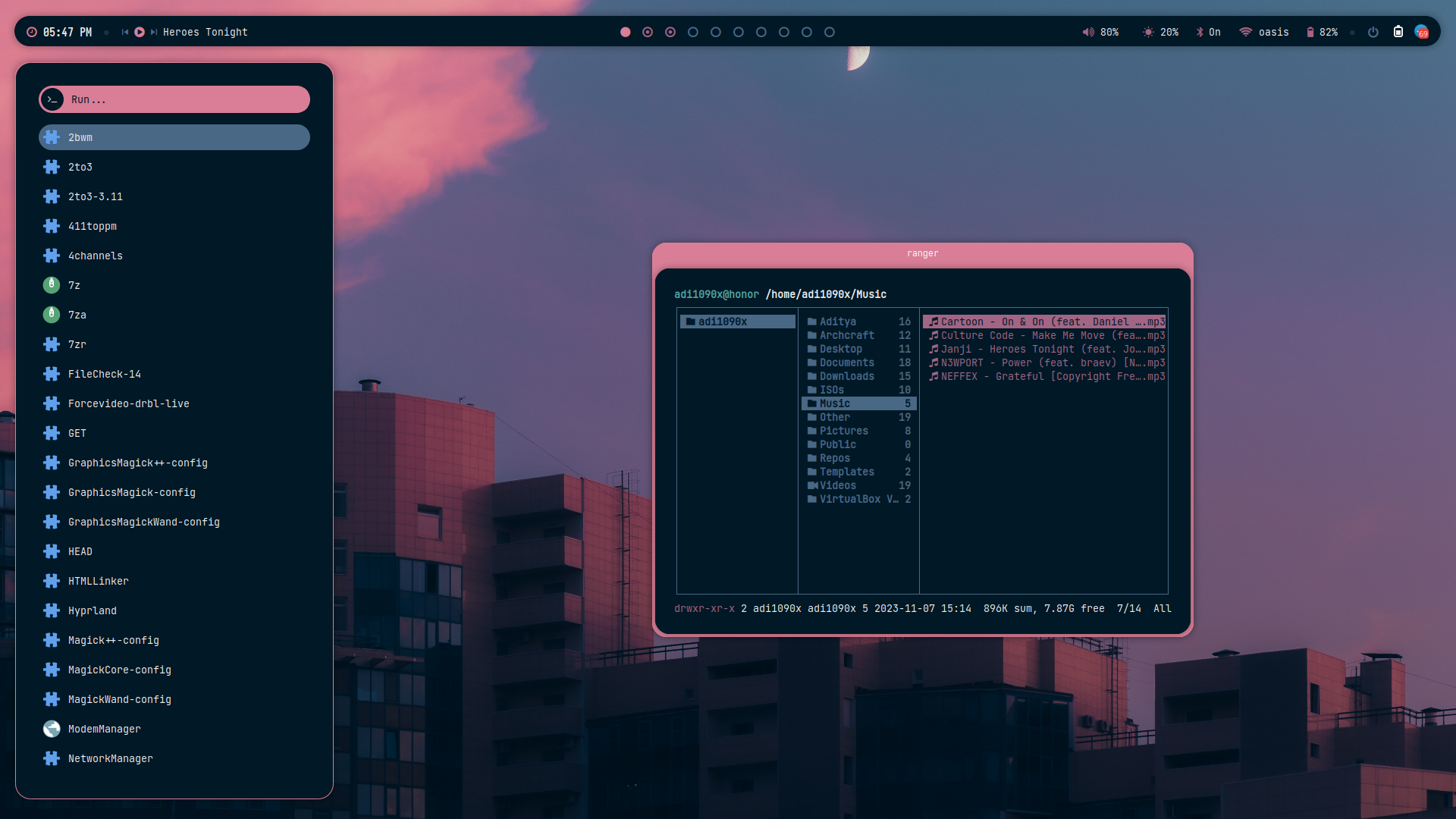 | 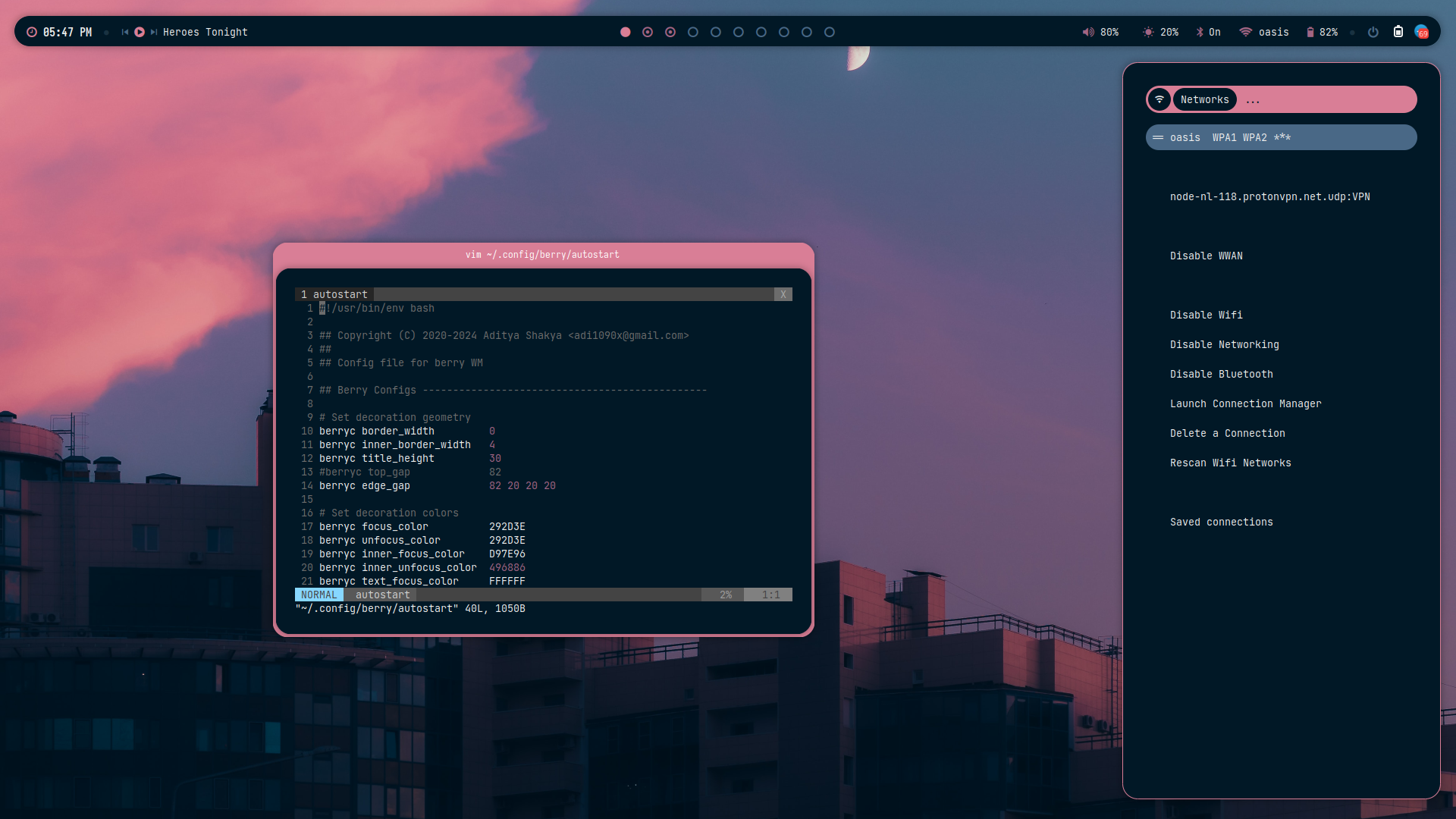 | 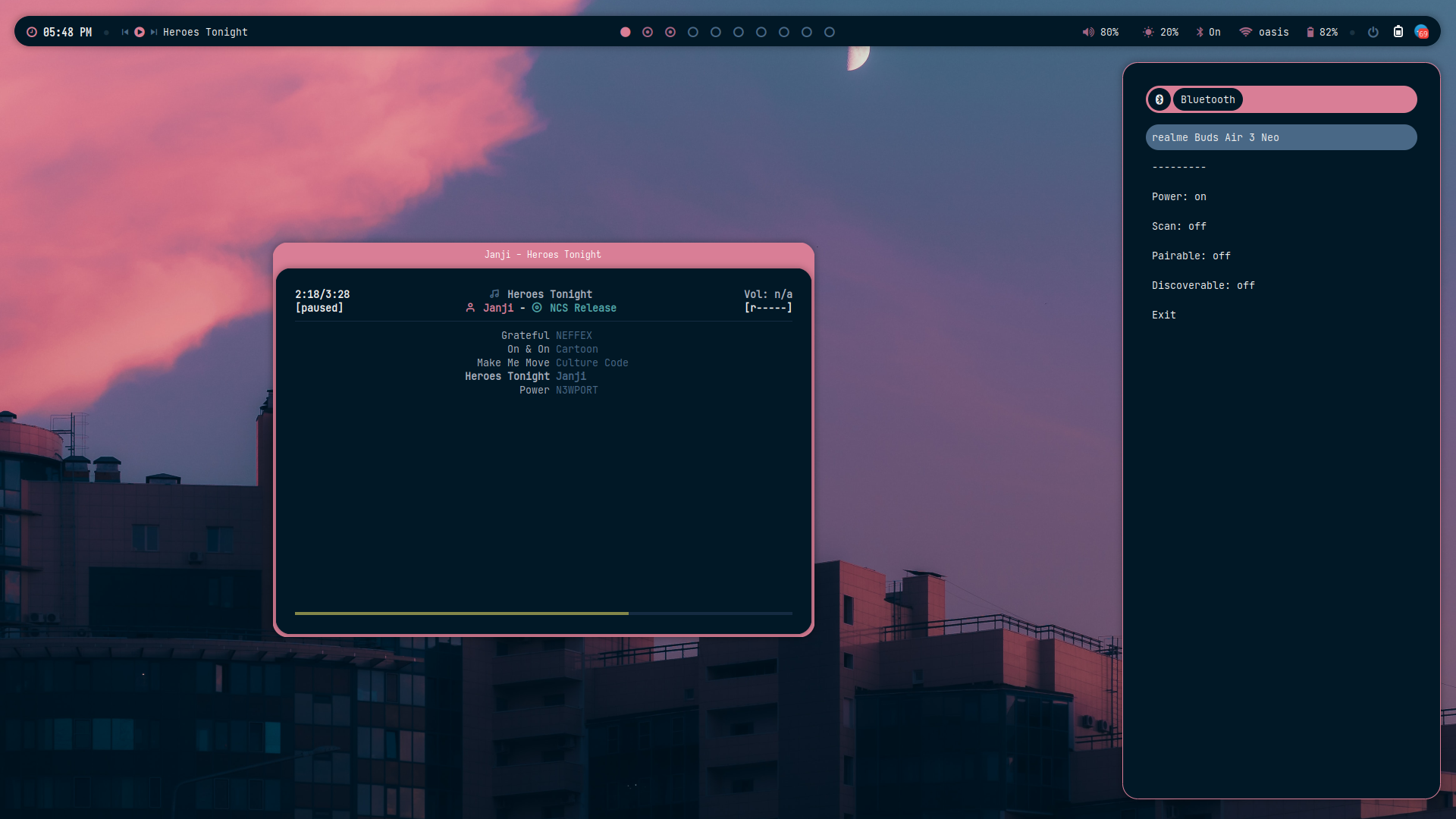 |
| Desktop 9 | Desktop 10 | Desktop 11 | Desktop 12 |
|---|---|---|---|
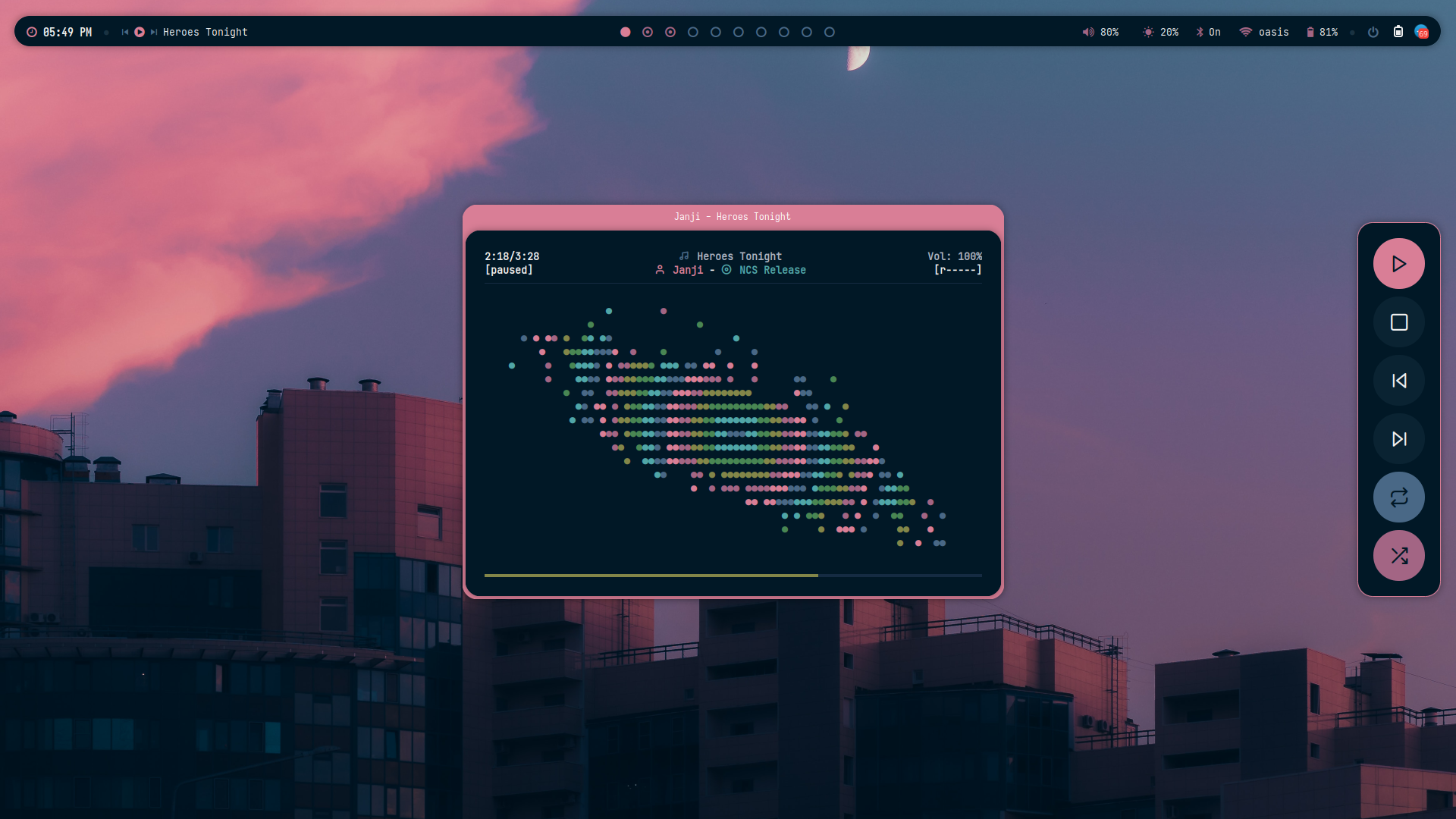 | 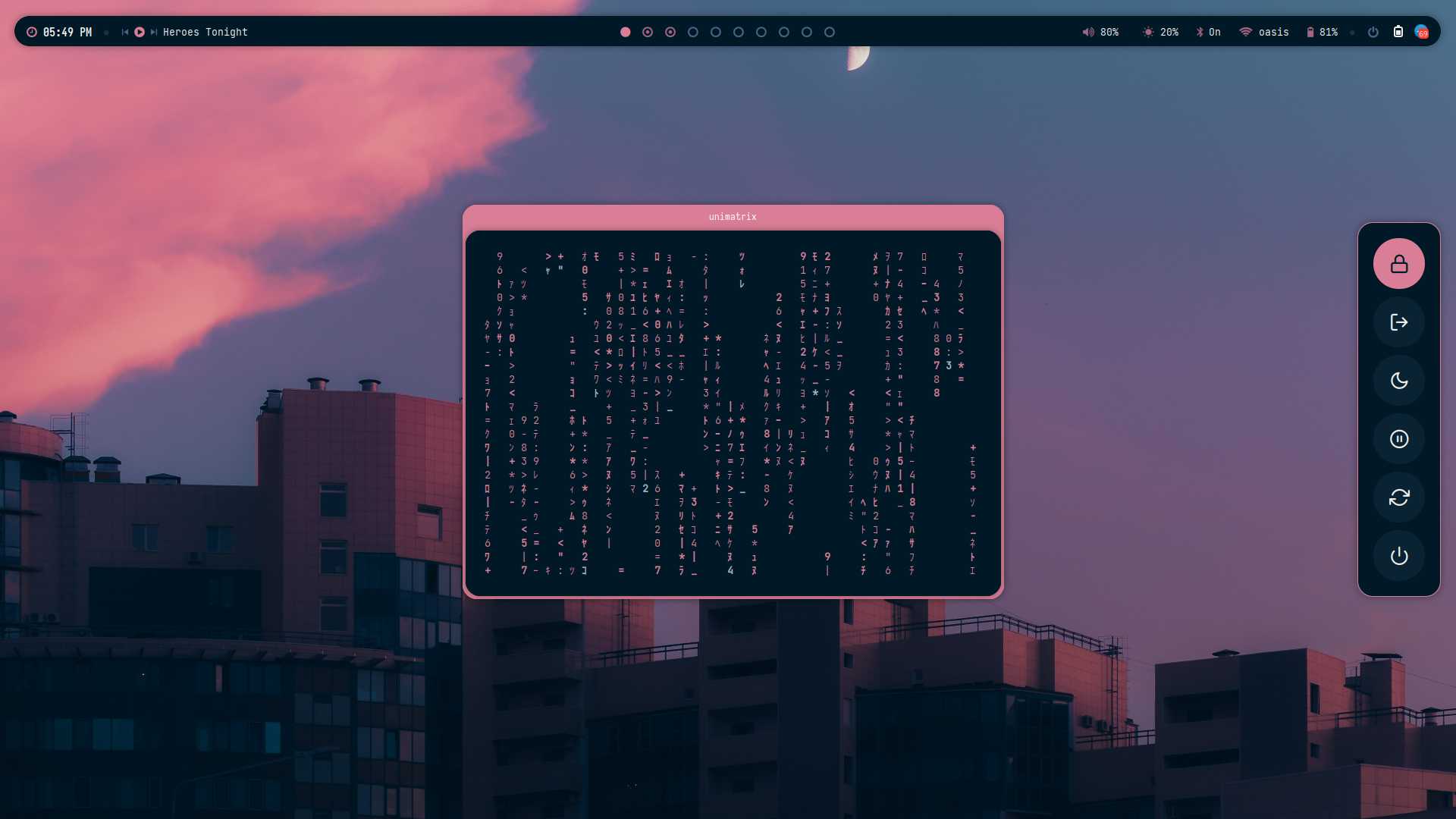 | 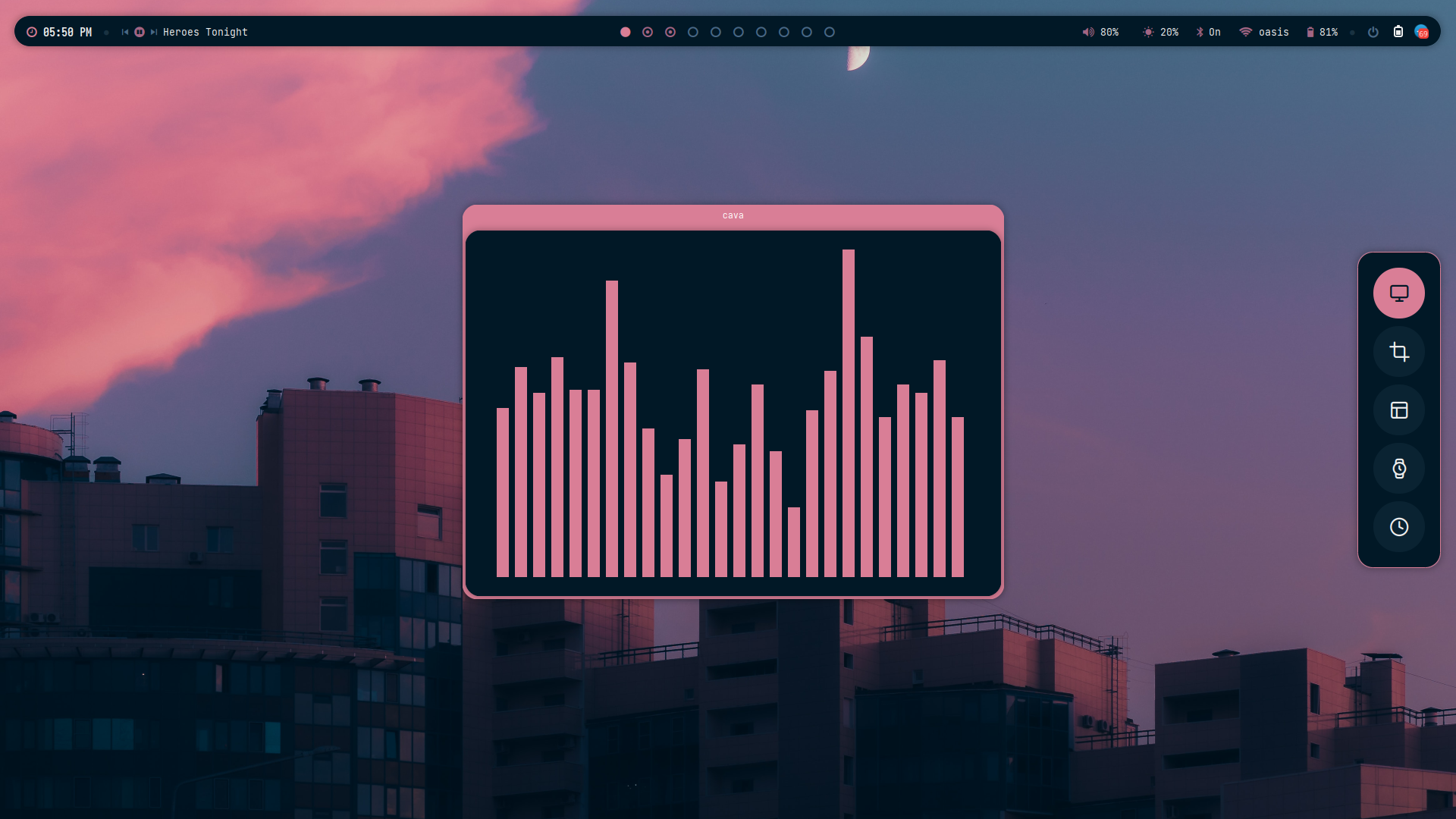 | 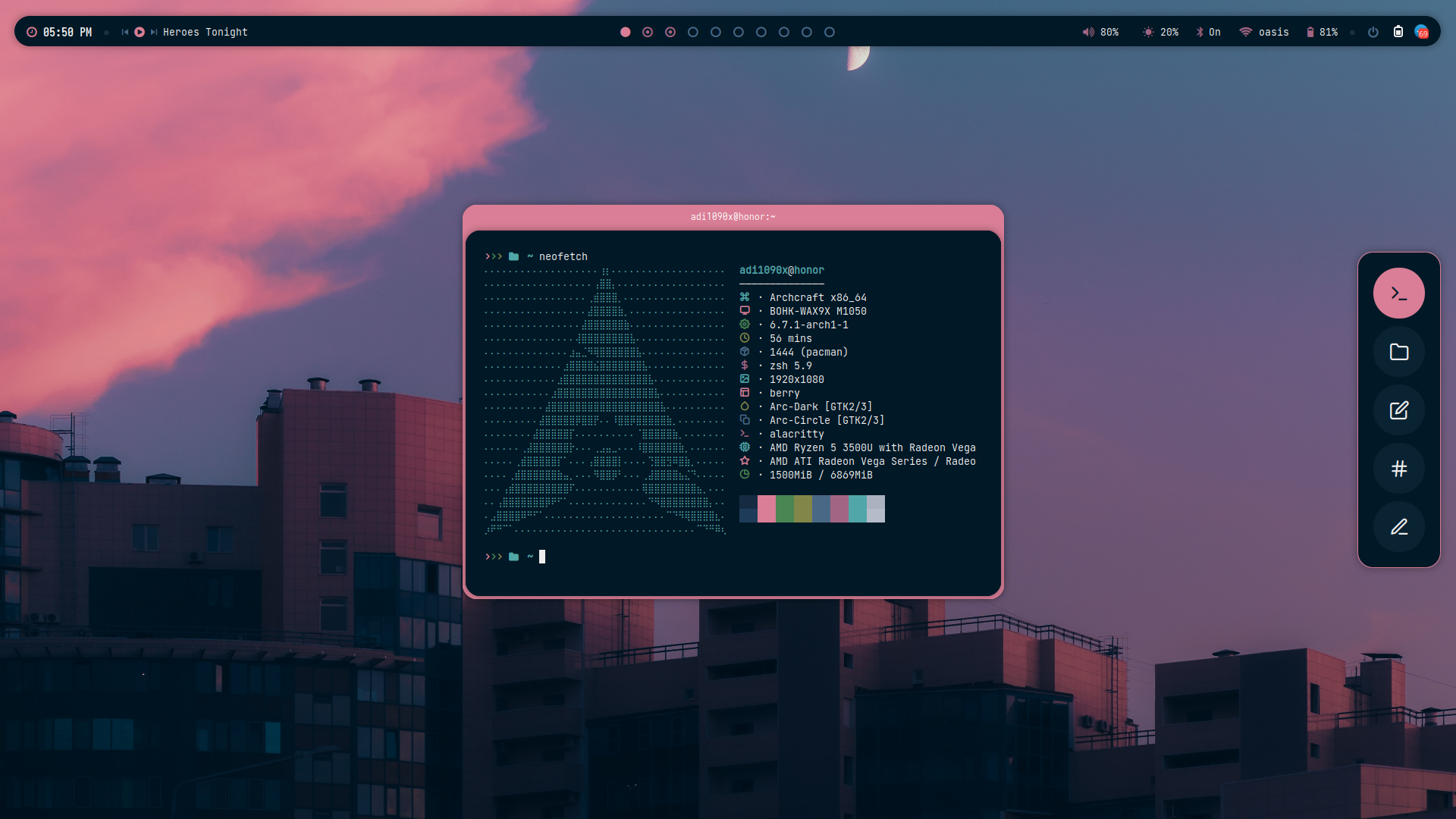 |
FAQs
How to update my config to new configs?
When a new version of Archcraft Berry get released, And you update the system by sudo pacman -Syu or you update the Berry package by sudo pacman -S archcraft-berry, New config files get installed as berry_pacnew_YYYY-MM-DD in your ~/.config directory.
To use new configs, backup your old ~/.config/berry directory and move ~/.config/berry_pacnew_YYYY-MM-DD to ~/.config/berry and login again.
How to change GTK theme, icons and cursor?
To change GTK theme, icons and cursor in Berry session, Edit ~/.config/berry/xsettingsd file and restart Berry to apply the changes.
Net/ThemeName "Catppuccin-Mocha"
Net/IconThemeName "Luv-Folders-Dark"
Gtk/CursorThemeName "Sweet"
How to manage multiple monitors and resolution in Berry?
If you use multiple monitors with Berry window manager, you can manage them by running Manager Monitors or archcraft-randr app.
Why Alacritty is not working on my computer?
Since Alacritty is a OpenGL based terminal emulator, It may not work on some computer hardwares. You can make it work on such computers by following these methods :
- Open alacritty with LIBGL_ALWAYS_SOFTWARE=1 variable. Edit the keybindings/script launching alacritty and replace
alacrittywithLIBGL_ALWAYS_SOFTWARE=1 alacritty - Edit /usr/share/applications/Alacritty.desktop desktop file and replace
Exec=alacrittywithExec=env LIBGL_ALWAYS_SOFTWARE=1 alacritty